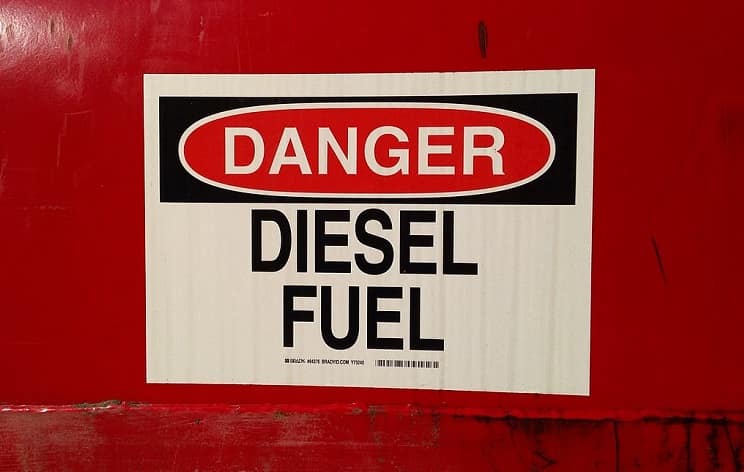If an emergency strikes, you will need fuel for your generator or bug-out vehicle.
Compared to gasoline storage, diesel fuel lasts much longer and is easier to store.
However, just like gasoline, diesel fuel will go bad. You can make your diesel fuel last much longer with the proper diesel storage methods.
How Long Does Diesel Last?
Depending on whom you ask, you’ll get a different answer about how long diesel fuel can last.
This is because the lifespan of diesel fuel largely depends on the conditions. Diesel stored in a cold area like Alaska will last longer than in sunny, humid Florida.
The diesel fuel sold today differs significantly from the diesel fuel several decades ago. The old type of diesel fuel could last for years without a problem.
Today’s diesel fuel is ultra low sulfur diesel. Low sulfur means that emissions are lower, but it also means that the fuel won’t last as long.
You can expect today’s diesel fuel to last:
- 6 to 12 months: If the temperature is kept around 70 degrees F
- 12+ months: If the temperature is kept below 70 degrees F
There are many anecdotal reports of diesel fuel lasting much longer than this. I’ve read in forums of diesel fuel lasting 10+ years and being okay. However, you’ll risk ruining your machines if you use expired diesel.
What makes diesel go bad?
If you want to store diesel for the long term and make it last longer, you’ve got to understand what makes diesel go bad. The biggest culprits for causing diesel to go bad are:
- Water/condensation
- Heat
- Microbial activity (bacteria and fungus growth)
- Contact with zinc or copper
Of these factors, water is probably going to be your worst enemy.
Even if you live in a dry area with slight temperature fluctuation, your tanks will still have condensation.
The condensation causes your diesel to gel and encourages bacteria and fungus growth.
Signs Diesel Fuel Has Gone Bad
- Gelling or sludge – Learn more about diesel gelling
- Darker color
- Sediment
- Fuel filters clogged frequently
- Poor fuel efficiency
- Damaged fuel pumps
- Harder to start machine
- Black smoke
- Rotten smell (caused from byproducts of microbes)
In theory, you can still use diesel fuel after it has gone bad. However, it will be hell for your machines.
Gelled diesel will clog filters and end up in your engines – leading to failure. The acids in old diesel will cause part corrosion and injector deposits.
It is simply not worth the risk of ruining your machines, so watch for signs of spoilage.
How to Store Diesel Fuel

First, you must decide how much diesel fuel you need to store. I recommend keeping no more than what you’d use in 12 months.
This way, you can rotate through the stored diesel, adding more to your stockpile as necessary.
Diesel Storage Drums
You can buy 5 gallon diesel cans. Storage in cans is pretty straightforward. If you need to store a bit more diesel, then you can get 55 gallon drums.
The problem with diesel drums is that they don’t have a drain on the bottom. There will be no way to remove sediment or bad diesel from the drum. If the diesel starts going bad, you are pretty much screwed.
To make sure the diesel lasts in the drums:
- Don’t let water pool on top of the drum: It will cause the drum to corrode, affecting the fuel.
- Keep the temperature consistent: I know this isn’t always possible, but fluctuations in temperature will cause condensation and water accumulation. You might consider an earth-sheltered building.
- Rotate! Use the first-in, first-out method to make sure your diesel is getting rotated before it goes bad.
- Clean drums between fillings: Before putting new diesel into a drum, clean it. Read how here.
- For shorter term storage, consider storing diesel in plastic containers
Diesel Storage Tanks
A tank can be a good solution if you need more diesel fuel. The great thing about tanks is that they should have a drain on the bottom. Since sludge, water and bacteria settle on the bottom of the tank, you can drain off these impurities.
Here are tips to make sure your diesel lasts in a tank:
- Consider an underground tank: You’ll have to check your local regulations for installing an underground tank. While this option is pricier and more complicated, it will allow you to keep your tank free of water and at a fairly consistent temperature.
- House above ground tanks: Put a roof over the tank to keep water off of it.
- Keep the tank full: The more space your tank has, the more room there is for condensation and microbial growth.
- Insulate tanks: Cold weather can cause diesel to gel or ice to form within the tank. Insulation helps prevent this.
- Check your fuel regularly: Look for signs that the diesel is going bad, like gelling or scum. Let the diesel sit so the scum goes to the bottom if this occurs. Then drain off the bad diesel from the bottom outlet.
How to Make Diesel Last Longer
Aside from storing the diesel properly, you can do a few things to make it last longer.
There is a learning curve to using these products, so it might not be worth it for small amounts of diesel that get rotated.
For long-term diesel storage, though, you’ll need to implement these practices.
1. Biocides
Diesel biocides are added to prevent microbial growth, which is one of the major causes of diesel going bad. You can’t just dump biocide into the diesel tank, though. Read about how to use diesel biocides here.
These are two of the most popular brands of diesel biocide.
2. Stabilizers
These prevent oxidation and acid-based reactions in the diesel fuel. They can extend the life of your diesel fuel by years (though proper storage is still necessary). There are plenty of options for diesel stabilizers on the market.
The Sta-Bil brand of diesel stabilizer (Amazon link) is highly recommended and can keep fuel fresh for 24+ months.
3. Water Absorbers
These additives will attract water molecules and bond with them. The bonded water is trapped in the fuel, causing it to burn off as steam in the combustion chamber instead of spoiling the fuel.
There aren’t as many options for diesel water absorbers. If you live somewhere humid or subject to drastic temperature changes, you might want to consider this product. (Amazon link)
4. Filtering Old Diesel Fuel
Generally, you should dispose of any diesel fuel that has started to go bad. In a SHTF situation, though, you might be unable to replace the fuel. Filtering can clean the old diesel fuel and make it usable.
Let the diesel fuel sit (very still!) and most (but not all) of the sludge and sediment will settle to the bottom of the tank. Drain off the dirty diesel using the valve at the bottom of your tank.
Next, you’ll need to filter the old diesel to remove other impurities so they don’t get into your engines. Diesel fuel filters have hydrophobic coatings, which means they catch water and sediment.
This filter by Mr. Funnel is a good choice.
Are you storing diesel long-term? Let us know any tips or problems that you have encountered!






I did back-up fuel installations for the military and VA hospitals for about 5 years.
Most importantly keep water out of your diesel, add silca gel breathers to the vents on your tanks. Check your deliveries for water, you can use a glass jar, look at the bottom for water bubbles.
Do not accept bio-diesel.
If you are installing under ground you will have to go double wall and there are no drains on the bottom. I installed cheap farmer hand pumps on the tank tops with steel conduit drop pipes to the bottom of the tanks to pump the water and sludge out. Get some Kolor Kut or Gasoila water finding paste online. Rub some on a wooden stick to test for water at the bottom of the tank.
I built and designed fuel polishers that remove water and particulate from the diesel and kept it fresh for years. These were all 115v/230v for tanks from 500 to 50,000 gallons, but I could look at 12v. Hope this helps
For long term storage fo fuel I recommend installing a recirculation filter on your storage tanks. If installed correctly the system will take the fuel from the bottom of the tanks run it through a water separation filter and sediment filter (Raycor 1000 series will work great) and then pump it back into the tank. If you cycle the fuel in the system once every month or two and change the filters annually you can be assured that the fuel that you are using is water, sediment and algae free.
I just bought a fishing boat in Alaska that has been sitting for six years. It has a 671 Jimmy in it. My biggest concern is the fuel? I don’t know how many gallons are in each tank? If any additives were used before storage? Will this fuel damage my engine?
Hey T-rex – impossible to say without testing it. Is it showing any of the signs of going bad as listed in the article?
A 671 will stick an injector if it gets any water in the fuel then you replace the injectors if you can a stick in tank use water paste to check for water change fuel filters often
old jimmy mac
Leon